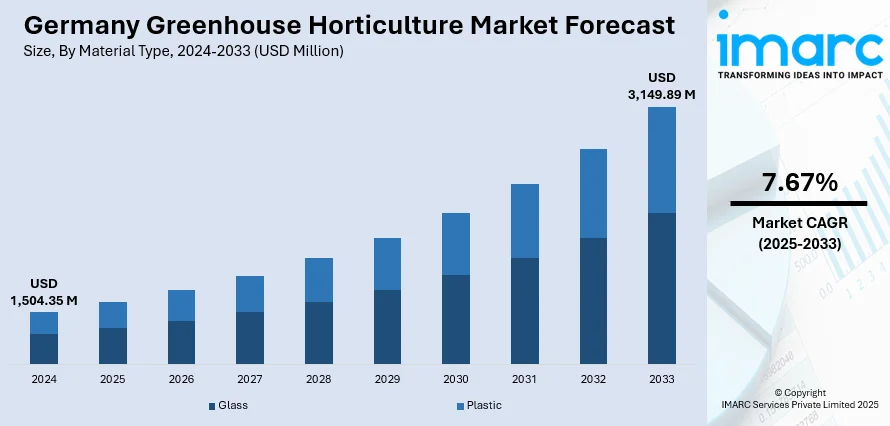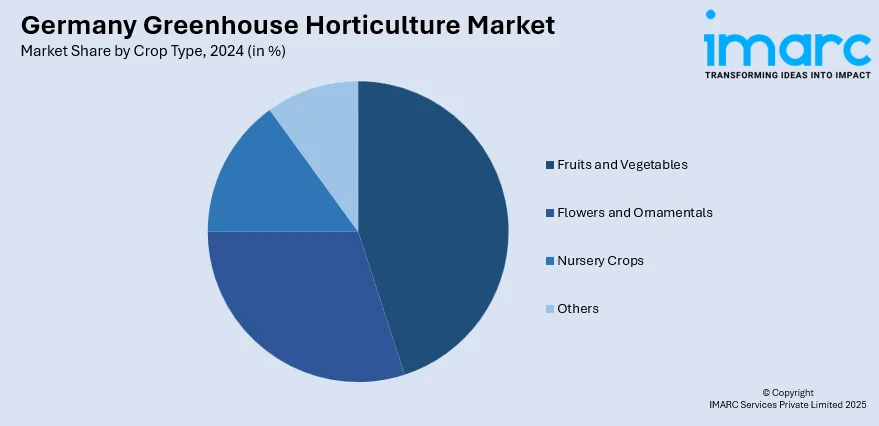
Germany Greenhouse Horticulture Market Size, Share, Trends and Forecast by Material Type, Crop Type, Technology, and Region, 2025-2033
Germany Greenhouse Horticulture Market Overview:
The Germany greenhouse horticulture market size reached USD 1,504.35 Million in 2024. The market is projected to reach USD 3,149.89 Million by 2033, exhibiting a growth rate (CAGR) of 7.67% during 2025-2033. The market is fueled by the increasing need for fresh, high-quality produce, especially within urban regions where greenhouse horticulture is available for cultivation throughout the year. Furthermore, the growth of precision farming and smart greenhouse solutions, which increase productivity and resource utilization, further augments the Germany greenhouse horticulture market share.
|
Report Attribute
|
Key Statistics
|
|---|---|
|
Base Year
|
2024
|
|
Forecast Years
|
2025-2033
|
|
Historical Years
|
2019-2024
|
| Market Size in 2024 | USD 1,504.35 Million |
| Market Forecast in 2033 | USD 3,149.89 Million |
| Market Growth Rate 2025-2033 | 7.67% |
Germany Greenhouse Horticulture Market Trends:
Advanced Climate-Control and Automation Technologies
The market is seeing fast uptake of sophisticated climate-control systems, which incorporate high-precision monitoring devices for temperature, humidity, and CO₂ levels. Such systems tend to use IoT sensors, AI-powered analytics, and automated ventilation or irrigation to ensure ideal growing conditions throughout the year, regardless of prevailing weather conditions. Additionally, automation encompasses operations like fertigation, spacing, and pest detection, lessening labor reliance while enhancing yield consistency. Apart from this, robotics and machine vision are progressively used for grading and harvesting with greater efficiency in operations. Predictive data models facilitate farmers in anticipating climatic changes and real-time adjustment of parameters, which ensures the health of crops and lessens losses. These technological advancements not only optimize resource use but also support compliance with Germany's stringent environmental standards.

To get more information on this market, Request Sample
Expansion of Organic and Sustainable Cultivation Practices
The market is witnessing a significant move toward organic and eco-certified production, as consumers increasingly ask for sustainably grown produce. Furthermore, farmers are adopting soil-less methods of cultivation, like hydroponics and aquaponics, to reduce water usage and limit the degradation of soil. Organic production techniques focus on the utilization of biological pest control, natural fertilizers, and unmodified seed varieties, which match European Union requirements for organic certification. In addition to this, closed-loop water recycling solutions and rainwater collection are on the rise to cater to environmental issues and regulatory requirements. Also, the use of biodegradable substrates and recyclable packs adds to the market's eco-friendliness. Apart from that, most manufacturers are incorporating renewable energy sources like solar panels or biomass heating units into their processes, thereby reducing their carbon footprint. This green revolution is favorably contributing to the Germany greenhouse horticulture market growth.
Diversification into High-Value and Specialty Crops
The market is increasingly diversifying into high-value and specialty crops, such as exotic herbs, microgreens, edible flowers, and premium tomato varieties. This trend responds to growing demand from gastronomy, health-conscious consumers, and the specialty retail sector. Controlled environment agriculture allows producers to cultivate crops that are otherwise unsuitable for Germany's temperate climate, enabling year-round availability and stable pricing. Furthermore, premium quality, flavor consistency, and visual appeal are key selling points, often supported by branding that emphasizes local and sustainable production. Growers are also targeting niche markets, such as medicinal plants and nutraceutical crops, capitalizing on the rising interest in functional foods. Apart from that, advanced lighting systems, including spectrum-adjustable LEDs, are used to optimize flavor profiles, nutrient content, and growth rates of these specialty plants. This diversification not only boosts profitability but also mitigates market risks by reducing dependency on traditional crops like lettuce or cucumbers, thus strengthening the resilience of greenhouse operations against price volatility and seasonal fluctuations.
Germany Greenhouse Horticulture Market Segmentation:
IMARC Group provides an analysis of the key trends in each segment of the market, along with forecasts at the country and regional levels for 2025-2033. Our report has categorized the market based on material type, crop type, and technology.
Material Type Insights:
- Glass
- Plastic
The report has provided a detailed breakup and analysis of the market based on the material type. This includes glass and plastic.
Crop Type Insights:

- Fruits and Vegetables
- Flowers and Ornamentals
- Nursery Crops
- Others
A detailed breakup and analysis of the market based on the crop type have also been provided in the report. This includes fruits and vegetables, flowers and ornamentals, nursery crops, and others.
Technology Insights:
- Heating System
- Cooling System
- Others
A detailed breakup and analysis of the market based on the technology have also been provided in the report. This includes heating system, cooling system, and others.
Regional Insights:
- Western Germany
- Southern Germany
- Eastern Germany
- Northern Germany
The report has also provided a comprehensive analysis of all the major regional markets, which include Western Germany, Southern Germany, Eastern Germany, and Northern Germany.
Competitive Landscape:
The market research report has also provided a comprehensive analysis of the competitive landscape. Competitive analysis such as market structure, key player positioning, top winning strategies, competitive dashboard, and company evaluation quadrant has been covered in the report. Also, detailed profiles of all major companies have been provided.
Germany Greenhouse Horticulture Market News:
- May 2024: Hexafarms, a German startup, announced the successful closing of a EUR 1.3 Million pre-seed funding round, bringing its total capital raised to over EUR 2.5 Million. The new investment will be directed toward enhancing the company’s AI and machine learning capabilities and expanding its R&D team to further optimize greenhouse food production. Hexafarms aims to reduce variable costs and losses by nearly 30% while currently processing approximately 9 Million kilograms of strawberries and tomatoes this quarter and offering the broadest crop portfolio in Europe.
Germany Greenhouse Horticulture Market Report Coverage:
| Report Features | Details |
|---|---|
| Base Year of the Analysis | 2024 |
| Historical Period | 2019-2024 |
| Forecast Period | 2025-2033 |
| Units | Million USD |
| Scope of the Report |
Exploration of Historical Trends and Market Outlook, Industry Catalysts and Challenges, Segment-Wise Historical and Future Market Assessment:
|
| Material Types Covered | Glass, Plastic |
| Crop Types Covered | Fruits and Vegetables, Flowers and Ornamentals, Nursery Crops, Others |
| Technologies Covered | Heating System, Cooling System, Others |
| Regions Covered | Western Germany, Southern Germany, Eastern Germany, Northern Germany |
| Customization Scope | 10% Free Customization |
| Post-Sale Analyst Support | 10-12 Weeks |
| Delivery Format | PDF and Excel through Email (We can also provide the editable version of the report in PPT/Word format on special request) |
Key Questions Answered in This Report:
- How has the Germany greenhouse horticulture market performed so far and how will it perform in the coming years?
- What is the breakup of the Germany greenhouse horticulture market on the basis of material type?
- What is the breakup of the Germany greenhouse horticulture market on the basis of crop type?
- What is the breakup of the Germany greenhouse horticulture market on the basis of technology?
- What is the breakup of the Germany greenhouse horticulture market on the basis of region?
- What are the various stages in the value chain of the Germany greenhouse horticulture market?
- What are the key driving factors and challenges in the Germany greenhouse horticulture market?
- What is the structure of the Germany greenhouse horticulture market and who are the key players?
- What is the degree of competition in the Germany greenhouse horticulture market?
Key Benefits for Stakeholders:
- IMARC’s industry report offers a comprehensive quantitative analysis of various market segments, historical and current market trends, market forecasts, and dynamics of the Germany greenhouse horticulture market from 2019-2033.
- The research report provides the latest information on the market drivers, challenges, and opportunities in the Germany greenhouse horticulture market.
- Porter's five forces analysis assist stakeholders in assessing the impact of new entrants, competitive rivalry, supplier power, buyer power, and the threat of substitution. It helps stakeholders to analyze the level of competition within the Germany greenhouse horticulture industry and its attractiveness.
- Competitive landscape allows stakeholders to understand their competitive environment and provides an insight into the current positions of key players in the market.
Need more help?
- Speak to our experienced analysts for insights on the current market scenarios.
- Include additional segments and countries to customize the report as per your requirement.
- Gain an unparalleled competitive advantage in your domain by understanding how to utilize the report and positively impacting your operations and revenue.
- For further assistance, please connect with our analysts.
 Request Customization
Request Customization
 Speak to an Analyst
Speak to an Analyst
 Request Brochure
Request Brochure
 Inquire Before Buying
Inquire Before Buying




.webp)




.webp)












